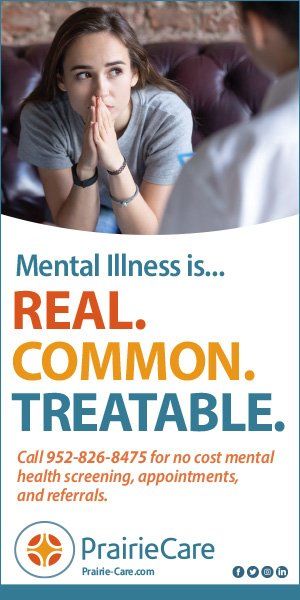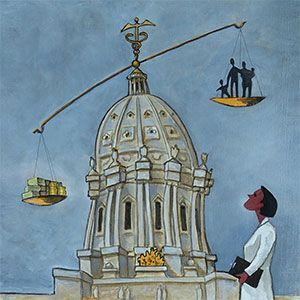he Interstate Medical Licensure Compact Commission (IMLCC) was born from an idea proposed at the April 2013 Federation of State Medical Boards’ meeting of the House of Delegates, when a resolution was adopted to formally explore the creation of a new physician licensure system. It was based on a simple question, with a complex answer: “What are the common standards of licensure that could be verified by one and accepted by many?” The IMLCC began accepting applications for the new process which answered that simple question in April 2017. Since that time over 13,000 physicians have used the process—submitting over 26,000 applications and receiving over 40,000 licenses.
August 2022
VOLUME XXXVI, NUMBER 05
August 2022, VOLUME XXXVI, NUMBER 05
Medicine and the Law
The Interstate Medical Licensure Compact Commission
Expanding your practice opportunities
BY Marschall S. Smith

Minnesota physicians represent about 300 of the applications and 2,000 licenses—placing the Minnesota Board of Medical Practice squarely in the middle, volume wise, of the 39 member states processing applications. Information published by the Federation of State Medical Boards indicated that nationally about five percent to seven percent of all licensed physicians in the United States hold licenses and practice in more than one state. So far, the Compact’s processing numbers indicate that, on average, about two percent of those physicians used the Compact process to obtain those multiple licenses. The processing information in Minnesota is reflective of these national trends. The Compact is generally a word-of-mouth organization, but we are working on a promotional video to provide information to hospital groups and physician organizations who can spread the word, driving the participation number up with the hope of doubling over the course of the next two to three years.
How it Works
The IMLCC became a legal organization when, on April 15, 2015, the Governor of Alabama signed legislation authorizing establishment of the IMLCC in that state. With this action, Alabama became the seventh state to authorize the IMLCC, creating a legal threshold that made it possible for the implementation of the IMLCC to proceed. The 39 member jurisdictions are made up of 37 states, one territory and the District of Columbia. The remaining 13 states and three territories are in various stages of the joining process. There are currently three states with active legislation. And there has been interest expressed by six states and one territory about joining the Compact in the upcoming legislative season. We are actively working with medical boards, physician associations, hospital groups and patient advocacy organizations to close the loop with full participation.
Generally, all requested licenses are issued in seven to ten days.
The COVID pandemic continues to impact the need for an expedited process for physicians to obtain licenses. It has highlighted the critical role played by the IMLCC and our member board staff in providing states with a safe, effective pathway to meeting that need. The expansion of telemedicine has played a critical role in providing the coverage, and the IMLCC has played a part in this expansion, but it remains one of the key reasons physicians use the IMLCC process. The others include regional licensure and locum tenens physicians, with a new use coming into play of hospital systems changing the way to provide post-treatment and inter-treatment care options. Generally, physicians prefer the Compact process over reciprocity recognition because the Compact process results in a full, unrestricted license that helps clarify issues about scope of practice, insurance billing and malpractice insurance concerns to name a few. Additionally, the Compact process is as quick as reciprocity recognition documentation that is required by many states with that option.
Minnesota is the home to several major health care systems and nationally recognized centers of health care excellence—meaning that Minnesota physicians have use of the IMLCC process to critically impact the care provided to patients across the U.S.. A small but significant example is found by reviewing a map. The distance to concentrations of physicians, who are generally found in urban areas, in the upper sections of Wisconsin are closer to Minnesota than the urban areas of Wisconsin. Anecdotal reports from rural health care facilities in Wisconsin have noted that services and hours of operations have been expanded due to the increased pool of available physicians.
The IMLCC is premised on the concept that medical licensing is state based, in part to ensure that each state can provide healthcare that is safe and meets its citizen’s expectations. In order to practice medicine, the physician must be licensed where the patient is receiving care. In many states, the IMLCC statute is the first time this premise was codified, which again helps to facilitate the effective, safe use of telemedicine as a treatment modality.
So how does a physician use the Compact process to their advantage? The entire process is done using a single online application. The application is found at imlcc.org, which includes educational videos that can be viewed to understand the application process and documents required to complete the application. Once the application is started, it can be saved and completed at a later time. When completed and payment has been made, the State of Principal License (SPL) is notified of the application immediately.
The key to the process is to establish eligibility. The first step is for a physician to establish a State of Principal License or SPL. The physician must hold a full, unrestricted license issued by the SPL, and either live or work in the SPL. This is the key to the expedited nature of the Compact process. The SPL has already gathered and holds the primary sourced information for the static data elements required by all member boards, i.e., medical school attended, USLME/COMPLEX attempts, GME training dates and completion information, etc. A physician using the Compact process must always maintain an SPL, and there are processes to change or “Redesignate” the SPL that can be done at any time without cost after the Letter of Qualification has been issued. Changing an SPL does not impact the Letter of Qualification.
The next step is to pre-qualify yourself. There are nine questions asked that will be verified by a primary source by the SPL. The detailed descriptions and requirements are found on the Compact webpage, in the educational videos and in the on-line application. A summary of these nine elements is:
- Graduated from an accredited medical school.
- Successfully completed ACGME or AOA accredited graduate medical education.
- Passed each component of the USMLE or COMLEX-USA in no more than 3 three attempts for each component.
- Hold board a current ABMS or AOABOS board certification.
- Have no disciplinary actions reported to the National Practitioner Data Bank (NPDB).
- A clean criminal history.
- Have no actions taken against your controlled substance permission/license.
- Not have any current or pending board investigations.
- Submit to a fingerprint-based FBI background check.
There is a non-refundable application fee of $700.00 to apply for the Compact process. The application fee is used to operationalize the single online application process and is quickly recouped by the ability to start work quicker. Additionally, it is more cost effective than applying for two or more state licenses when the costs related to obtaining the primary source data for each application are required by each state when using the traditional method.
This first step generally takes about 30 to 45 days, with the majority of the processing time taken experienced in obtaining the results from the FBI fingerprint-based background check.
Generally, all requested licenses are issued in seven to ten days.
The Next Steps
Once the SPL has finalized its eligibility determination, the physician is notified via email that a Letter of Qualification has been issued. About 9% of applications are determined not to meet the eligibility requirements, with the most common reasons being not holding a current active board certification or still in residency. The physician logs back into their account, selects the states from which they wish to obtain a license and pays the licensing fee owed for that license (as determined by each state). Generally, all requested licenses are issued in seven to ten days. The Letter of Qualification is valid for 365 days, which can be used at any time to obtain additional licenses. The result is that a physician can obtain and hold 1 to 38 licenses, with a single on-line application, in 37 to 55 days on average (processing times vary and depend on application completeness and member boards).
The cost for a license from a state varies from state to state and board to board. The cost to obtain a full unrestricted license is the same whether it is through the Compact or traditional path. In the “About” tab on the Compact’s webpage, a list of the license costs by state are detailed, with a range of $60.00 to a high of $817. The Nevada DO board has suspended license fees for 12 months starting in July 2022, so the cost for a license from that state is a nominal $0.01, which is refunded shortly after the license is obtained. The cost for renewals is not listed, as not all states have standardized renewal fees; however, the cost is the same as for traditionally obtained licenses.
The top five specialties of physicians using the Compact process are: Internal Medicine, Family Medicine, Psychiatry and Neurology, Radiology and Emergency Medicine. Internal Medicine represents about 30% of the specialties. The number of physicians who use the Compact fall into three broad groups that are about equal in number: Locum Tenens physicians, telemedicine physicians and physicians extending their practice to a nearby state or region. The most recent example of Compact process usage is found in situations where patients in need of highly specialized care or complex conditions can now more readily receive coordinated post-treatment care with their local physician working remotely with their out-of-state treating physicians licensed in the state where the patient resides. This helps the patient avoid costly travel expenses and increases the quality of care as it is coordinated rather than handed off.
States who have joined the Compact have experienced an average of 10% to 15% increase in their physician workforce. Patients in rural, frontier and medically underserved areas benefit by increasing the pool of available physicians through telemedicine provided by a physician licensed in their state. Hospitals in rural and frontier areas are able to keep their doors open and even expand hours due to the increased number of licensed physicians, many of whom can provide those services remotely.
Looking Ahead
In a relatively short period of time, the IMLCC has achieved much to be proud of. Among the key highlights:
- The Compact continues to grow. The Compact legislation has passed in 37 states, the Territory of Guam and the District of Columbia.
- The Compact has been a success. Applications received and processed have doubled each year since 2019. More than 8,000 applications have been received and processed between January 2022 and July 2022—more than the 6,995 received in the 12 months of 2021.
- Physicians use the Compact. Between January 2022 and July 2022, more than 13,000 licenses have been issued using the Compact process—a strong indicator that the process works and fills a need in the physician community.
- The Compact is fiscally sound. The IMLCC’s operational functions are paid through a budget based on revenues generated from the application fees paid by physician applicants. The IMLCC annually reviews its fee schedule to ensure that it is appropriate.
The Interstate Medical Licensure Compact Commission was created as an answer to the challenge of finding common standards verified by one and accepted by many. Through the hard work and dedication of the IMLCC commissioners, member board staff and IMLCC staff, the challenge was answered.
Check out the Compact on our webpage at imlcc.org. In addition to the application and educational videos, there is a FAQ section for physicians, publications and other information like the monthly update of the number of applications processed and licenses issued.
Marschall S. Smith
is the executive director of the Interstate Medical Licensure Compact Commission.
Inside the IMLCC Numbers
| Data Questions | April 2018 Results | April 2019 Results | April 2020 Results | April 2021 Results | April 2022 Results |
|---|---|---|---|---|---|
| Number of completed applications included in the data study | 654 | 2,845 | 2,995 | 3,653 | 4,510 |
| Average number of licenses obtain per applicant | 3.0 | 3.0 | 1.6 | 4.0 | 4.0 |
| Percentage who obtains one or two licenses | 68 | 64 | 80 | 58 | 63 |
| Percentage who obtains three or more licenses | 32 With 13% obtaining 7 or more licenses | 36 With 13% obtaining 7 or more licenses | 20 With 6% obtaining 7 or more licenses | 42 With 14% obtaining 7 or more licenses | 37 With 15% obtaining 7 or more licenses |
| Percentage of applications with a determination that the physician did not meet the eligibility requirements | 32 With 13% obtaining 7 or more licenses | 10 | 16 | 9 | 9 |
| Percentage of the applications which were additional license requests using the original Letter of Qualification but a separate applicationer | 11 | 20 | 26 | This data field is no longer tracked by the IMLCC system. | This data field is no longer tracked by the IMLCC system. |
| Average number of days from application received to Letter of Qualification (LOQ) issued | 34 With 33% obtained in 15 days or less | 36 With 32% obtained in 15 days or less | 37 With 34% obtained in 15 days or less | 50 With 33% obtained in 30 days or less (please note the change in our tracking mechanism) | 52 With 35% obtained in 30 days or less |
| Average number of days from the date an applicant is determined to be qualified to the date the requested licenses are issued | 15 With 45% obtained in 7 days or less | 19 With 51% obtained in 7 days or less | 21 With 53% obtained in 7 days or less | 18 With 54% obtained in 7 days or less |
MORE STORIES IN THIS ISSUE
cover story one
The Moral Law Within: Care beyond medical services
By JULIA JOSEPH-DI CAPRIO, MD, MPH
cover story two
Care Coordination: Improving patient satisfaction and engagement
Bonnie LaPlante, MHA, RN
capsules
Top news, physician appointments and recognitions
Interview
Improving the Experience of Health Care
Hilary Marden-Resnik, President and CEO
Medicine and the Law
The Interstate Medical Licensure Compact Commission: Expanding your practice opportunities
BY Marschall S. Smith
Administration
The Minnesota Rare Disease Advisory Council: A new resource for patients and clinicians
BY Erica Barnes, Ma, CCC-SLP
Health Care Policy
Physician Advocacy: You are needed now
BY PETER DEHNEL, MD
AUGUST 2024
cover story
Assessing and Advancing Community Health: The overarching value of equity
BY Brooke Cunningham, MD, PhD
CONTACT
(612) 728-8600 | comments@mppub.com
758 Riverview Ave | St. Paul MN 55107
© Minnesota Physician Publishing · All Rights Reserved. 2023
quick links
We welcome the submission of manuscripts and letters for possible publication. All views and opinions expressed by authors of published articles are solely those of the authors and do not necessarily express those of Minnesota Physician Publishing Inc., or this publication. The contents herein are believed to be accurate but are not intended to replace medical, legal, tax, business or other professional advice or counsel. No part of this publication may be reprinted or reproduced without written permission from our publisher.



















